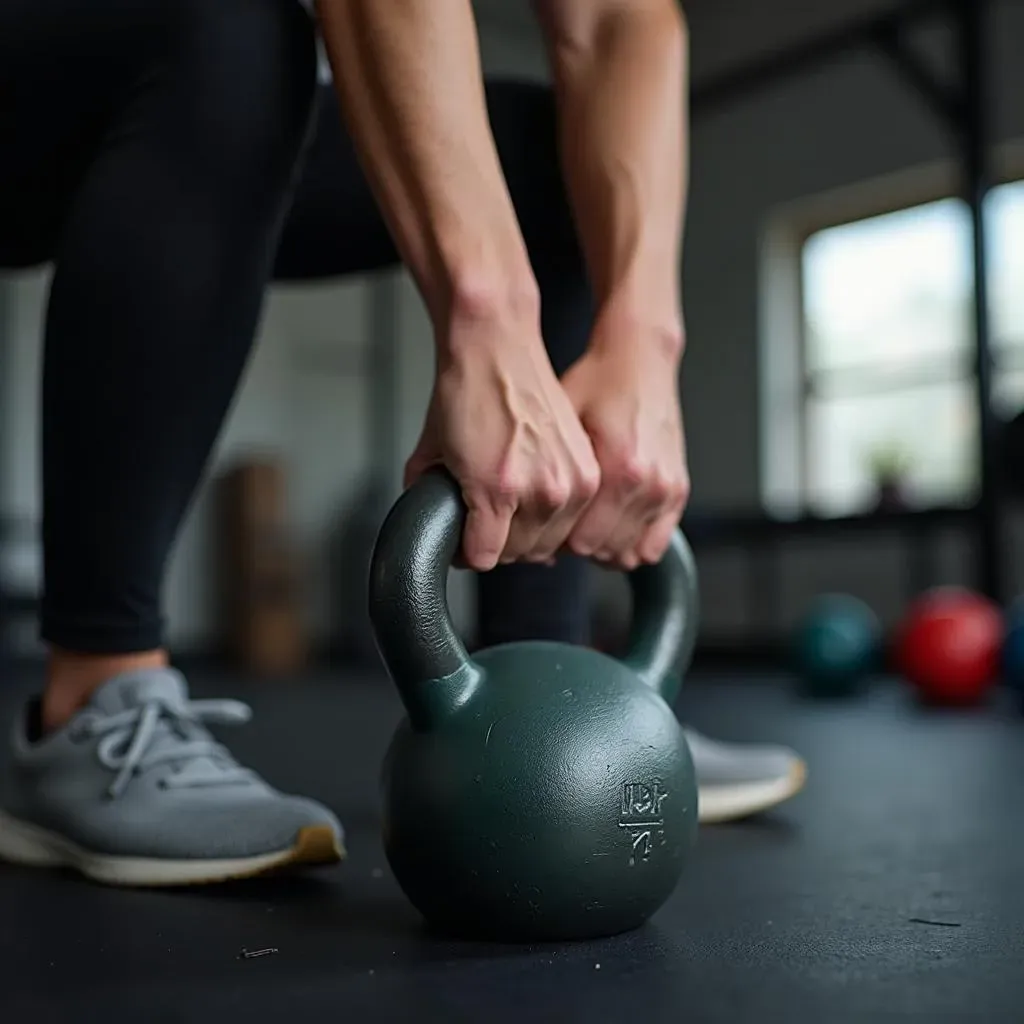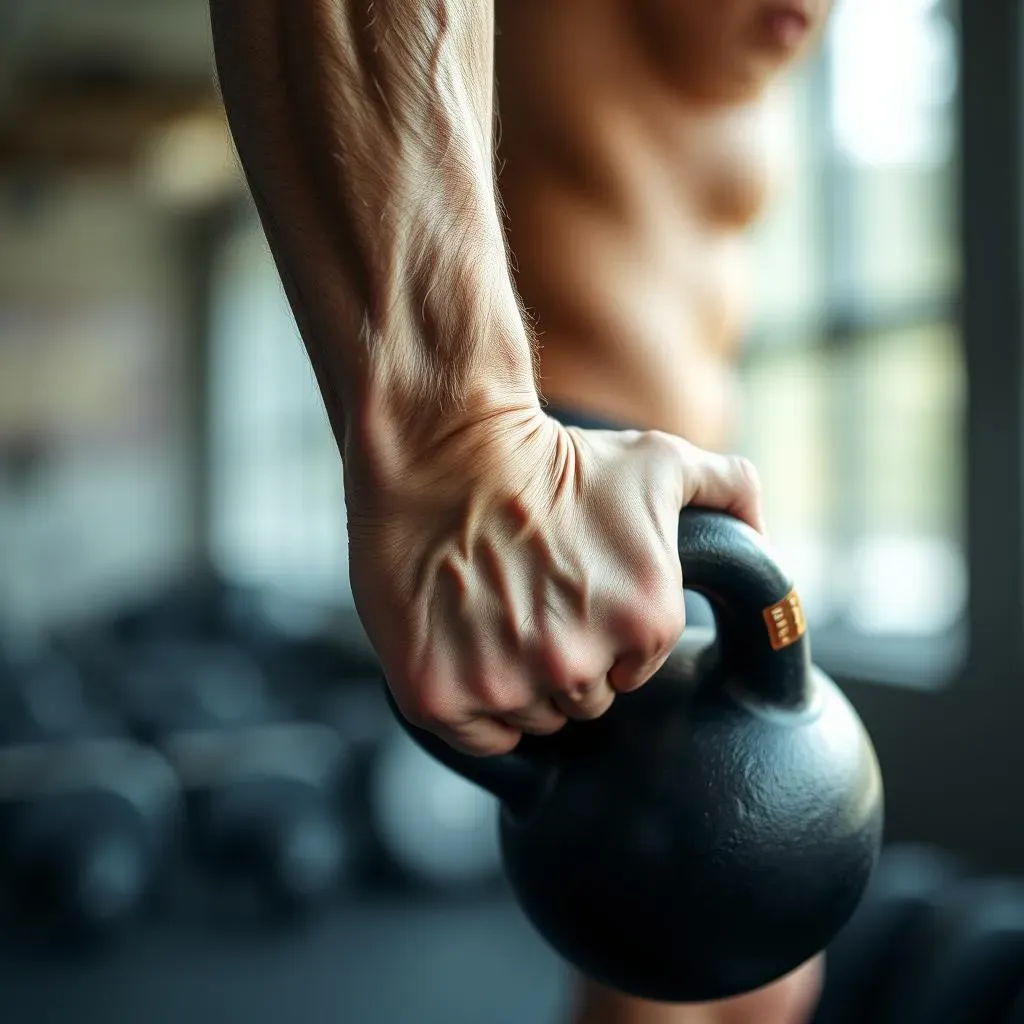Table of Contents
Are you tired of the same old bicep workouts? Do you feel like your arms aren't growing, no matter how many curls you do with dumbbells? Well, it's time to shake things up. Forget what you think you know about bicep training, because we're about to enter the world of the bicep kettlebell. Yes, that cannonball with a handle can be your secret weapon for building impressive arms. This isn't just about swinging a heavy weight around; it's about using the kettlebell's unique shape to target your biceps in ways you never thought possible. We'll explore why bicep kettlebell exercises are so effective, dive into the best moves for building muscle, and give you the techniques to perform them like a pro. Plus, I’ll point out some common mistakes, so you don't waste your time doing things wrong. Get ready to discover a new approach to bicep training that will have you seeing results faster than ever before.
Why Bicep Kettlebell Workouts Are a Game Changer

Why Bicep Kettlebell Workouts Are a Game Changer
Beyond the Basics
let’s be real for a second. Dumbbells are great. Barbells are cool too. But when was the last time you did something that truly challenged your biceps? A bicep kettlebell workout isn't just another way to curl; it's a total shift in how you approach arm training. The kettlebell's unique shape and weight distribution mean your muscles are working harder to stabilize each move. This isn't just about lifting; it’s about control and engagement. You’re not just building muscle, you are building functional strength that carries over to everyday life. I remember when I first started using kettlebells, I was surprised how much my forearms got involved. It was a whole new level of arm workout.
Think about it: the offset weight of the kettlebell forces your body to engage more muscles, making each exercise more effective. It's not just your biceps getting a workout; your core and forearms are also getting in on the action. This means you're not just building bigger arms, you're building stronger, more stable arms. It's like upgrading from a regular car to a sports car; same basic function, but way more power and finesse.
The Unique Kettlebell Advantage
The beauty of the kettlebell lies in its versatility. You can grip it in so many different ways, each one hitting your biceps from a slightly different angle. This is key for complete muscle development. Plus, the kettlebell’s design allows for a more natural range of motion compared to dumbbells. It's not just about curls either. You can incorporate kettlebells into exercises like hammer curls, concentration curls, and even rows to target the biceps indirectly. I had a friend who was stuck in a plateau with dumbbells, but then he switched to kettlebells and his bicep progress went through the roof. It’s that change of pace your muscles need.
Also, the kettlebell promotes better grip strength, which is often overlooked but is important for overall strength. Holding onto that thick handle works your hand and forearm muscles in ways that dumbbells simply can't. So, not only are you building bigger biceps, but you're also getting a grip that will make everyday tasks easier and make you feel like you can crush anything. It’s a win-win situation.
Advantage | Description |
|---|---|
Unique Shape | Engages more muscles for stability and strength. |
Versatile Grips | Allows for different angles and complete muscle development. |
Natural Motion | Promotes a more natural range of motion. |
Grip Strength | Improves forearm and hand strength. |
Top Kettlebell Exercises for Bicep Growth

Top Kettlebell Exercises for Bicep Growth
The Classic Kettlebell Curl
Let's start with the basics, but with a kettlebell twist. The kettlebell curl is a staple for a reason; it directly targets your biceps. But holding a kettlebell changes the game. The offset weight challenges your stability and grip strength, making your muscles work harder than with a dumbbell. It's not just about lifting the weight up and down; it's about controlling the kettlebell throughout the entire movement, squeezing your bicep at the top. Think of it like this: you are not just lifting the kettlebell, you're guiding it, making sure every muscle fiber in your bicep is engaged. It’s a small change that makes a huge difference.
I remember when I first started doing kettlebell curls, I felt a burn in my biceps that was different from my dumbbell days. It was like my muscles were finally waking up. The key is to keep your elbows tucked in and your core tight. Avoid swinging the kettlebell; that’s cheating and it's not going to build muscle. Focus on controlled movements and feel the muscle working. Start with a lighter weight until you nail the form, then gradually increase the weight as you get stronger. Trust me, your biceps will thank you.
Hammer Curls with a Kettlebell
Now, let's talk hammer curls. These are great for hitting the brachialis, a muscle that sits under your bicep and adds to the overall thickness of your arm. When you do hammer curls with a kettlebell, you can hold it by the horns of the handle, this grip shifts the focus and really activates those brachialis muscles. It’s like giving your biceps a whole new dimension. It's not just about size; it's about creating a well-rounded, powerful looking arm. I like to think of the brachialis as the unsung hero of arm day; it does the work in the background, and make your arms look bigger overall.
The kettlebell hammer curl also emphasizes grip strength because you need to hold onto the bell. As you lift the kettlebell, maintain a neutral wrist position. Focus on squeezing your bicep and brachialis at the top of the movement. Lower the kettlebell slowly, resisting the pull of gravity. This control is what builds muscle. Don’t just let the weight drop; make it work for you on the way down. These little tweaks can make a big difference in your results. It's about quality over quantity, and making every rep count.
Exercise | Target Muscle | Grip Style |
|---|---|---|
Kettlebell Curl | Biceps | Standard Grip |
Kettlebell Hammer Curl | Brachialis, Biceps | Horn Grip |
Kettlebell Bicep Curl Techniques: Getting It Right

Kettlebell Bicep Curl Techniques: Getting It Right
The Stance and Grip
let's talk about the nitty-gritty of the kettlebell bicep curl. It's not just about picking up the weight and curling; it's about setting yourself up for success. Start with your feet shoulder-width apart, just like you're about to do a regular standing curl. Now, the grip is where it gets interesting. For a standard curl, hold the kettlebell by the handle, letting it hang naturally. Make sure your grip is firm, but not death-grip tight. You want to be able to control the bell, but you don't want to waste energy clenching your fist too hard. Keep your chest up, core engaged, and your shoulders relaxed. This is your foundation; if this isn't right, the rest of the curl will be off. I always tell people, it's like building a house, you need a solid foundation to build on it.
Now, before you even think about curling, take a second to align your body. Your elbows should be tucked in close to your sides. This prevents you from swinging the weight and lets your biceps do the work. Think of your body as a solid plank. You don’t want to be rocking back and forth like you're on a boat. I've seen people try to cheat by using their back to lift the weight, and it never ends well. You want to isolate your biceps, so focus on keeping everything else stable and still. It's not about how much weight you can lift, but how well you can control it.
The Curl and the Control
Alright, so you're set up, now for the actual curl. As you lift the kettlebell, focus on contracting your bicep. Imagine you are squeezing your bicep at the top, like you're trying to show off your muscle. The movement should be smooth and controlled. Don't just yank the weight up. It’s about quality, not speed. I like to picture my bicep doing all the work, like it's the only muscle that's working. It's a mind-muscle connection thing, and it really helps.
As you lower the kettlebell, do it slowly and deliberately. Don't let gravity do all the work. This eccentric or negative portion of the lift is just as important as the lifting part. You are not just letting the weight fall down. Control the movement, feel your bicep resisting the weight. This is where you get a lot of muscle growth. It's like stretching a rubber band; you want to feel the tension. It's during this part of the curl, you are building strength and muscle. It's the most important part of the movement, so don't rush it.
Technique | Description |
|---|---|
Stance | Feet shoulder-width apart, core engaged |
Grip | Firm grip on the kettlebell handle |
Elbows | Tucked in close to the sides |
Movement | Smooth, controlled curl, squeeze at the top |
Lowering | Slow, controlled, resisting gravity |
Avoiding Common Mistakes in Your Bicep Kettlebell Routine

Avoiding Common Mistakes in Your Bicep Kettlebell Routine
Swinging and Momentum
let's get real about a big mistake I see all the time: swinging the kettlebell. It's tempting to use your whole body to heave the weight up, especially when it starts to feel heavy. But that's just cheating yourself out of a good workout. When you swing, you're not really engaging your biceps; you're using momentum to do the work. It's like trying to win a race by getting a push start every time; it doesn't count, and it certainly doesn't build muscle. I remember when I first started, I thought I was killing it with these big, swinging curls, but then I realized my biceps were hardly feeling it. It was all my back and shoulders doing the work. It’s a very common mistake but it is easy to avoid.
The key is to control the movement. Focus on isolating your biceps and using them to lift the weight. Keep your core tight, your elbows tucked in, and your body still. Imagine you're moving in slow motion. You want to feel the burn in your bicep with every single rep. If you start to swing or use momentum, it's a sign that the weight is too heavy. Lower the weight, and focus on the correct form. It's better to do fewer reps with good form than many reps with bad form. Remember, it’s about quality, not quantity. It's about making every single rep count.
Mistake | Why It's Bad | How to Fix It |
|---|---|---|
Swinging | Reduces bicep engagement, uses momentum | Control the movement, use lighter weight |
Using Back | Reduce bicep activation, risk of injury | Keep your core tight, stabilize your body |
Ignoring the Negative
Another common mistake is letting the kettlebell drop quickly on the way down. People focus so much on lifting the weight that they forget about the lowering part. But the negative portion of the curl is just as important, if not more so, for building muscle. It's like stretching a rubber band; you want to feel the tension as you release it. When you let the kettlebell drop, you're not giving your muscles a chance to work. It's like skipping half of your workout. I used to rush through the lowering part until I realized I was missing out on so much. It was a game changer when I slowed down.
The key is to control the descent. Lower the kettlebell slowly and deliberately, feeling the tension in your bicep. This is where you get a lot of muscle growth. It's like you're fighting gravity, and your muscles are working hard to resist it. Don’t just let the weight fall; make it work for you on the way down. It's during this part of the curl, you are building strength and muscle. It's the most important part of the movement, so don't rush it. Focus on the negative, and you will see real progress.
- Control the weight on the way down.
- Focus on the eccentric contraction.
- Don't let gravity do all the work.
Wrapping Up Your Bicep Kettlebell Journey
So, there you have it, a solid look at how to use kettlebells to seriously boost your bicep gains. You've seen why they are so effective, learned some killer exercises, and know how to avoid common pitfalls. The kettlebell isn't just a trendy piece of gym equipment; it’s a powerful tool for building real strength and muscle. Don't just read about it, though; get out there and try these bicep kettlebell moves for yourself. Start slow, focus on form, and gradually increase the weight. You’ll be surprised at how quickly you see and feel the difference. Now go on, make those biceps pop!